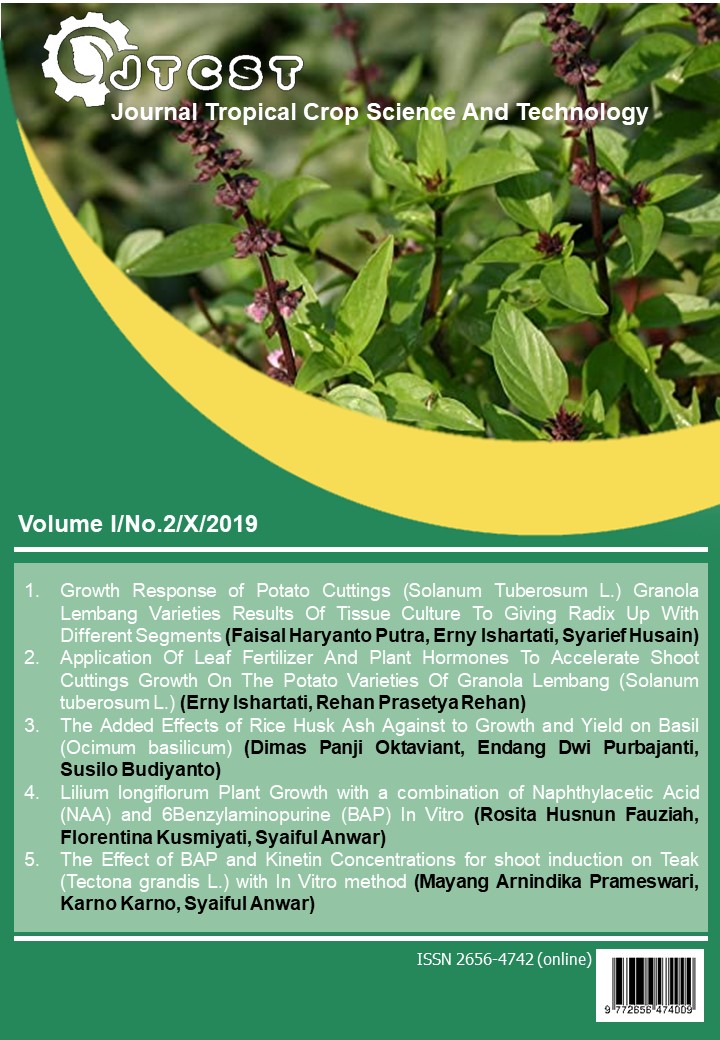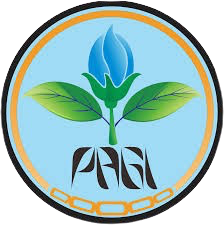Lilium longiflorum Plant Growth with a combination of Naphthylacetic Acid (NAA) and 6Benzylaminopurine (BAP) In Vitro
DOI:
https://doi.org/10.22219/jtcst.v1i2.10387Keywords:
Lilium longiflorum, NAA, BAP, in vitroAbstract
This research was aim to identify the effect of Naphthylacetic Acid (NAA) and 6-Benzylaminopurin (BAP) on growth of Lilium longiflorum planlet. The research method was Completely Randomized Design Factorial 4 x 4 with 4 replication. First factor was concentration of NAA, consist of A0: 0 mg/l, A1: 0,75 mg/l, A2: 1,5 mg/l, and A3: 2,25 mg/l. Second factor was concentration of BAP, consist of : B0: 0 mg/l, B1: 0,3 mg/l, B2: 0,6 mg/l, and B3: 0,9 mg/l. The observed parameters were number of shoots, plant height, number of leaves, number of roots, and percentage of contamination. Data were process by Analysis of Variance and continued by Least Significance Different (LSD). The result showed that combination of NAA and BAP did not significantly affect the growth parameter of Lilium longiflorum. BAP treatment significantly affected the number of shoots and number of leaves. The number of roots only observed in NAA treatment; 0,3 mg/l BAP + 0,75 mg/l NAA; 0,3 mg/l BAP + 1,5 mg/l NAA; and 0,6 mg/l BAP + 0,75 mg/l NAA. Percentage of fungal contamination was 7,5%. The conclusion of the result were the treatment 0f 0,3 mg/l BAP + 0,75 mg/l NAA was the best treatment for growth of Lilium longiflorum planlets with no contamination.
Downloads
References
Admojo, L., dan N.E. Prasetyo. (2016). Pengaruh sterilan terhadap tingkat kontaminasi pada kultur petiol dan midrib daun tanaman karet (Hevea brasiliensis Muell arg.) klon PB 330. Jurnal Penelitian Karet, 34 (2), 151 – 164.
Aslam, F., S. NAz, A. Tariq, S. Ilyas dan K. Shahzadi. (2013). Rapid multiplication ornamental bulbous plants of Lilium orientals and Lilium longiflorum. Journal of Bot, 45 (6), 2051-2055.
Bakhshaie, M., S. Khosravi, P. Azadi, dan H. Bagheri. (2016). Biotechnologi advance in Lilium. Journal of Plant Cell Reports, 35 (9), 1799-1826.
Elfiani dan Jakoni. (2015). Sterilisasi eksplan dan sub kultur anggrek, sirih merah, dan krisan pada perbanyakan tanaman secara in vitro. Jurnal Dinamika Pertanian, 30 (2), 117-124.
Han, B. H., H. J. Yu., B. W. Yae dan K. Y. Peak. (2004). In vitro micropropagation of Lilium longiflorum ‘Georgia’ by shoot formation as influenced by addition of liquid medium. Journal of Scientia Horticulturae, 103, 39-49.
Hoesen, D. S. H. (2009). Pembentukan tunas Lilium sp. secara ex vitro dan in vitro. Jurnal Teknologi Lingkungan, 10 (2), 183-193.
Karjadi, A. K., dan A. Buchory. (2007). Pengaruh komposisi media dasar, penambahab BAP, dan pikloram terhadap induksi tunas bawang merah. Jurnal Hortikultura. 18 (1), 1 – 9.
Lawalata, I.J. (2011). Pemberian beberapa kombinasi zpt terhadap regenerasi tanaman Gloxinia (Siningia speciosa) dari eksplan batang dan daun secara in vitro. Jurnal Exp.Life Sci, 1 (2), 83-87.
Mir, J.I., Ahmed, M. A. Sheikh, R. Rashid, dan S. H. Wani. (2012). In vitro propagation of Lilium (Lilium longiflorum), 82 (5), 65-68.
Pandey, R. K., A. K. Singh, dan M. Sharma. (2009). In vitro propagation of Lilium. International Journal, 1 (2), 26-28.
Rosyidah, M., E. Ratnasari, Y.S. Rahayu. (2014). Induksi kalus daun melati (Jasminum sambac) dengan penambahan berbagai konsentrasi 2,4-D dan BAP pada media MS secara in vitro. Jurnal Lentera Bio. 3 (3), 147-153.
Rufaida, A., Waeniaty, Muslimin, dan I. N. Suwastika. (2013). Organogenesis tanaman bawang merah (Allium ascalonicum L.) lokal palu secara in vitro pada medium ms dengan penambahan IAA dan BAP. Journal of Natural Science, 2 (2), 1-7.
Skoric, S., J. Savic, B. Siler, A. Sabovilevic, S. Todorovic, dan D. Grubisic. (2012). Efficient one-step tissue culture protocol for propagation of endemic plant, Lilium martagon var. cattaniae Vis. African Journal of Biotechnology, 11 (8), 1862-1867.
Sun, L., Z. Zhou, dan K. Cheng. (2013). Plant micropropagation from in vitro cultured bulb scales of Lilium lancifolum. Journal of Life Science, 10 (2), 2689-2692.
Tajuddin, R., i. N. Suwastika, dan Muslimin. (2012). Organogenesis tanaman anggrek hijau (Vitis vinifera L.) pada medium ms dengan penambahan IAA (indole acetid acid) dan berbagai konsentrasi BAP (benzil amino purin). Journal of Natural Science, 1 (1), 63-73.
Wulandari, C., W. E. Murdiono, dan N. Barunawati. (2018). Pengaruh konsentrasi sitokinin dan auksi terhadap pertumbuhan planlet Anthurium plowmanii Croat. Jurnal Produksi Tanaman, 6 (10), 2531-2538.
Yuniati, F., S. Haryanti, dan E. Prihastanti. (2018). Pengaruh hormon dan ukuran eksplan terhadap pertumbuhan mata tunas tanaman pisang (Musa paradisiaca var. Raja Bulu) secara in vitro. Buletin Agronomi dan Fisiologi, 3 (1), 20-28.
Downloads
Published
How to Cite
Issue
Section
License
Copyright (c) 2019 Rosita Husnun Fauziah, Florentina Kusmiyati, Syaiful Anwar

This work is licensed under a Creative Commons Attribution-ShareAlike 4.0 International License.
Authors who publish with this journal agree to the following terms:
- Authors retain copyright and grant the journal right of first publication with the work simultaneously licensed under a Creative Commons Attribution License that allows others to share the work with an acknowledgement of the work's authorship and initial publication in this journal.
- Authors are able to enter into separate, additional contractual arrangements for the non-exclusive distribution of the journal's published version of the work (e.g., post it to an institutional repository or publish it in a book), with an acknowledgement of its initial publication in this journal.
- Authors are permitted and encouraged to post their work online (e.g., in institutional repositories or on their website) prior to and during the submission process, as it can lead to productive exchanges, as well as earlier and greater citation of published work (See The Effect of Open Access).











